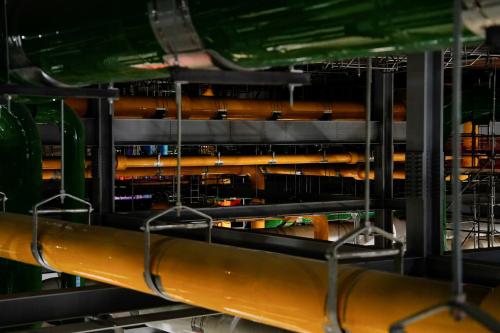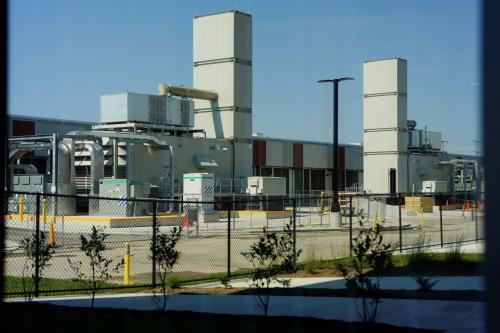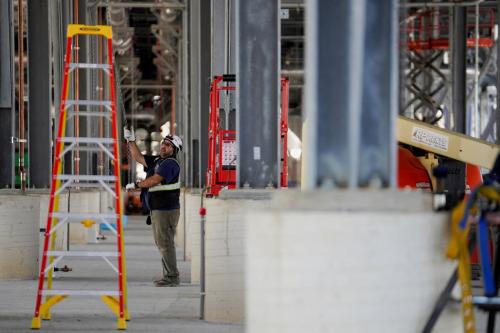Chicago is home to numerous research institutions, emerging tech clusters, and a strong industrial base, yet the region risked missing out on competitive federal funding authorized by the 117th Congress. This case study examines why and how philanthropic leaders—alongside state, university, and industry leaders—launched Innovate Illinois, a statewide initiative that has secured almost $1.5 billion in federal funding. Key takeaways for regional civic and philanthropic leaders include:
- Flexible philanthropic capital can be a critical enabler for complex, large-scale economic strategies—helping set the table for cross-sector collaboration to orient a wide range of stakeholders toward shared priorities with the highest potential for impact. However, sustaining this collaboration in the long term will require continued co-investment from state, university, and industry leaders.
- Philanthropic leaders are uniquely positioned to be strategic matchmakers to connect community leaders and neighborhood-level representatives with civic and industry decisionmakers about tech- and innovation-driven strategies. This ensures that local communities have an opportunity to shape, contribute to, and benefit from new investments.
- While philanthropic leaders can incentivize inclusion-oriented investments, these efforts will not succeed as one-off programs. Delivering tech-driven prosperity requires university, industry, and other strategic leaders to embed inclusion as a key driver of growth, and shape strategy accordingly.
The case study series
Between 2021 and 2022, the federal government passed major legislation authorizing nearly $4 trillion in economic investment, including $80 billion in place-based industrial policy. Brookings has been tracking these investments, including the early implementation of coalition-based grants aimed at advancing key national priorities such as national security and economic and technological competitiveness.
This case study is part of a report series that goes beyond the programmatic efforts catalyzed by these investments to examine the underlying civic infrastructure that regions have begun to build—and will ultimately need to sustain in the long term—to support resilient, inclusive, and innovation-driven economies.
The main report details five functions that regions need, with a particular focus on the unique role of local philanthropy in supporting these functions, both as funders and strategic partners. The five functions are:
- Connect networks and build trust among increasingly disconnected economic actors, including business leaders, community organizations, students, and entrepreneurs.
- Orient regional stakeholders toward a shared understanding of the economy and the pathways to inclusive growth.
- Activate key business leaders to inform, engage, and invest in strategic regional inclusive growth efforts.
- Integrate teams of diverse, complementary organizations to solve specific, high-priority challenges using evidence-based interventions.
- Mobilize resources through sustainable financial models to maintain momentum, using performance measurement tools to identify the highest-priority areas for investment.
The five case studies—Chicago/Illinois; Fresno, Calif.; New Orleans; Syracuse, N.Y.; and Tulsa, Okla.—illustrate how these functions and the philanthropic leadership that enables them play out on the ground. Each region has received different forms of federal funding under the 117th Congress, and also varies in size, geography, and maturity of economic and workforce development ecosystems—thus offering lessons for a range of philanthropic and civic leaders across the country.
Background
When the 117th Congress authorized nearly $4 trillion in federal spending, including $80 billion specifically for place-based industrial policy designed to drive inclusive, tech-based regional economic transformation, leaders across Chicago and Illinois leapt at the opportunity. Justifiably so: The state is home to key research assets such as Northwestern University, the University of Chicago, the University of Illinois system, the Argonne and Fermi National Labs, and a rapidly growing tech workforce (Chicago’s tech workforce grew by 18% between 2011 and 2022, compared to 1% for the overall city economy).
Yet the region and state significantly lagged their peers in the first wave of funding opportunities. During an early federal funding opportunity, university researchers and other leaders collectively submitted over 20 discrete proposals. This flurry signaled to local leaders and federal funders a need for greater cross-sector coordination across government, industry, academia, and nonprofit sectors to maximize the benefits of innovation-cluster-based growth. These leaders, including in the governor’s office and at the Civic Committee (which gathers Chicago’s top business and civic leaders), saw an opportunity to learn from early wins in other states—especially as they anticipated additional opportunities in this historic federal funding moment. The spark was lit at a board meeting for one of the national labs, with top leaders from each of the state’s major universities plus key civic leaders agreeing to bolster cross-institution, cross-sector coordination.
Within the span of weeks, the leadership of the state’s major universities—the University of Illinois system, the University of Chicago, and Northwestern—had joined forces with the governor, the region’s most influential business and civic leaders, and P33, a nonprofit public-private collaboration aimed at transforming Chicagoland into a top-tier tech hub driving inclusive economic growth. One philanthropic leader later called it “the genius trust.”
A missing piece was the connective tissue: a neutral, independent entity that could quickly and credibly coordinate across these sectors and institutions, provide flexible support to create strategies, and assemble the grant-writing and fundraising capabilities to actually secure competitive federal funding.
How civic and philanthropic leaders are mobilizing federal resources
Recognizing this critical opportunity, leaders across the state joined forces in early 2023 to launch Innovate Illinois, a statewide public-private collaboration designed to make the state investment-ready for federal resources. The effort focused on four priority pillars: “Beyond Silicon” (quantum), “Beyond Carbon” (clean energy and water), “Beyond Biology” (synthetic biology and precision fermentation), and “Beyond Boundaries” (inclusive workforce). Since its launch, Innovate Illinois has helped secure two Regional Technology and Innovation Hubs (Tech Hubs) designations, including a $51 million grant supporting precision fermentation and biomanufacturing to propel economic growth in Central Illinois; a National Science Foundation Regional Innovation Engines award of up to $160 million over 10 years to advance clean water technologies to support water-intensive industries; and a Recompete Pilot Program finalist award for advancing employment revitalization in Decatur, Ill. It has also been instrumental in realizing a $500 million state investment in quantum computing, complementing the Bloch Tech Hub’s work in the same area.
Importantly, it was an investment of a few million dollars that created the flexible, near-term support for coalition-building, technical support, grant-writing capacity, and strategic communications. The investment came from philanthropic contributions from Builders Vision, the Chicago Community Trust, the Joyce Foundation, the MacArthur Foundation, and the Pritzker Traubert Foundation, as well as direct and leveraged contributions from the state.
Innovate Illinois existed at the margins of most of these philanthropic foundations’ typical scope of investments. All had aligned interests, with the Chicago Community Trust and MacArthur Foundation each investing in helping communities access federal resources, and with all five supporting technology and clean energy initiatives to varying degrees. Some, such as the Joyce Foundation, also had flexible resources ready to be deployed to support regional prosperity. But for these foundations, which invest in programs and initiatives in the Chicago region, an initiative like Innovate Illinois—a university- and industry-led initiative intended to help advance inclusive, tech-driven economic development across the state—was not a typical investment.
Why, then, did these five foundations ultimately decide to prioritize funding for Innovate Illinois? In short, Innovate Illinois presented a unique, time-limited opportunity to achieve outsized returns. The motivating question, according to one philanthropic leader, was: “How do we, at a local level, sit alongside all this federal money and help our partners bring as much of it as possible to our region?”
Moreover, the major federal funding programs, such as Tech Hubs, were intentionally designed to ensure that historically excluded communities—both urban and rural—would have opportunities to contribute to and benefit from tech-driven innovation and growth. Thus, philanthropic leaders saw an opportunity to significantly benefit historically underinvested communities—a core funding priority. As one recounted, a relatively modest, one-time investment in Innovate Illinois’ capacity had potential to generate “multiple eight-figure business and workforce development wins for the South and West sides—a remarkable leverage and impact opportunity from a philanthropic perspective.”
How civic leaders leveraged flexible philanthropic support to coordinate Chicago’s big bets on economies of the future
Philanthropic leaders have played two uniquely important roles in this collaborative cross-sector initiative. First, their distinctively flexible investments have helped build nimble resources and capacity for statewide collaboration. Second, as strategic matchmakers, they have used their networks and influence to push for greater inclusion and community engagement in Innovate Illinois’ processes and outcomes.
Structurally, key civic leaders embedded strategic collaboration across universities, businesses, government, and community organizations in the design of Innovate Illinois:
- Governance: Innovate Illinois is chaired by the governor, with two co-chairs representing universities and business.
- Fiscal sponsor: The University of Illinois Urbana-Champaign (UIUC), the state’s land grant university, holds and manages Innovate Illinois’ budget and financial resources.
- Staff: Innovate Illinois is primarily staffed by senior staff at P33 and UIUC, with regular engagement from the governor’s office and other relevant state offices. Innovate Illinois operates on a loaned staff model, meaning that these staff and organizations are not compensated for their time coordinating this effort.
- Community engagement: Core Innovate Illinois staff have engaged the United Way of Metro Chicago (UWMC), involving them in coalition-based funding opportunities and informing them of other relevant neighborhood-level federal funding opportunities.
On community engagement, Innovate Illinois’ philanthropic investors have played a pivotal role. Their support was contingent on Innovate Illinois —which primarily represents business, university, and government interests—intentionally connecting with community and other civic organizations that could ensure Innovate Illinois’ strategies both address real community needs and activate the fullest potential of talent and other community assets across the state.
Accordingly, Innovate Illinois has engaged leaders at UWMC. For example, Innovate Illinois’ leadership enlisted UWMC’s network of neighborhood-level leaders to first understand local needs and priorities that should shape new investments, and later to share additional relevant federal funding opportunities, sometimes offering grant-writing capacity to support submissions.
More generally, the philanthropic foundations provided uniquely flexible resources for Innovate Illinois’ main contribution: clearing the field to orient the region’s stakeholders toward—and arrange resources behind—the state’s most promising investment-ready strategies, aligned with the state’s industry and innovation assets in the “Beyond” pillars outlined above. For example, when the Economic Development Administration (EDA) announced the Tech Hubs program, Innovate Illinois put out a statewide call for two-page proposals. Simultaneously, its structure and networks enabled Innovate Illinois to quickly establish an executive committee of key university, community college, and business and industry leaders who would review all submissions and identify the most compelling, competitive proposals with the best chance of securing federal funding in the national competition while driving inclusive growth locally. Innovate Illinois also used part of its budget to hire an independent team of consultants to specifically judge proposals against EDA criteria; the state also was involved to assess and ensure strategic alignment with its priorities.
Once the top two Tech Hubs proposals had been identified, Innovate Illinois shifted its focus to channel resources toward helping those coalitions strengthen their applications. Here, Innovate Illinois aligned with state resources—including pre-established consulting contracts—to support grant-writing. In parallel, philanthropic investments provided uniquely flexible resources that enabled staff supporting Innovate Illinois to connect coalition leads with management consultants—as needed, when needed— to provide grant-writing, grant development, media and marketing, strategic communications, and other capacity to strengthen their proposals in the federal competition. Innovate Illinois also leveraged its close engagement with the state to bolster the coalitions’ federal advocacy efforts, setting up meetings with decisionmakers in Washington, D.C. and supporting strategic communications efforts to promote the two Tech Hubs proposals before the EDA made its final funding decisions.
The role of philanthropy for the future of Chicago’s tech-driven economy
Chicago’s business, civic, community, and philanthropic leaders now face an important choice. If excitement over new grants and federal recognition fades and old ways of working return, then recent investments may spark some growth but will not address long-standing inequities in the city and region. But with continued, deliberate action, leaders can harness technological change for shared prosperity. Philanthropy has a key role to play by helping community organizations get directly involved in shaping and delivering regional strategies. This includes tailored capacity-building efforts at these organizations to empower them to fully connect and partner with civic leaders at the regional scale, contributing to strategy design and implementation.
Funders can also provide performance and impact-tracking capabilities—both within their organizations and by supporting external efforts—to ensure accountability. This is particularly important as the work progresses from design to implementation. Place-based philanthropic actors tend to have a deep understanding of their communities and are well positioned to track the progress and impact of these tech-driven cluster strategies—and, where appropriate, hold stakeholders to account. Critically, the work of ensuring inclusive, tech-based growth will require embedding attention to inclusion not only in talent and workforce efforts (as it typically is), but also across business development and innovation priorities.
In any case, Chicago’s philanthropic leaders have played an instrumental role in catalyzing inclusive, tech-driven economic opportunity by leveraging the recent federal investment moment. Whether through continued support of Innovate Illinois or otherwise, it is likely that these leaders’ continued involvement will be critical for ensuring that the state’s tech-based strategies deliver meaningful and tangible benefits to all its communities.
Key takeaways for civic and philanthropic leaders
One key lesson for regional leaders interested in advancing strategic growth is that relatively small philanthropic investments in entities like Innovate Illinois can align a wide variety of stakeholders to achieve significant impact in a short period of time. Yet philanthropy is often unwilling to underwrite these collaborations over the long term unless there is clear co-investment of money, time, and effort by state, industry, and university leaders to align and support inclusive, tech-based growth strategies.
A second key lesson is that philanthropic leaders can be strategic matchmakers who connect community leaders and neighborhood-level representatives with civic decisionmakers. Economic development strategies often focus on how regions and states can compete in industries and markets that operate globally, and consult industry leaders, entrepreneurs, and scientists to ensure industry and technological relevance. Philanthropic leaders often start from a place of improving the socioeconomic conditions of residents and neighborhoods, especially those suffering the consequences of discrimination and underinvestment. New forms of inclusive economic development pursue investments that recognize global market relevance and local economic benefit can be mutually reinforcing—but this requires intentional action. In that way, philanthropic leaders can leverage their relationships with and knowledge of surrounding communities to bring these community leaders—including both grasstops representatives from nonprofits and other community-serving institutions and grassroots neighborhood leaders—to ensure ongoing work, both through and beyond Innovate Illinois, is informed by a robust understanding of the regional economy and its barriers and opportunities.
Finally, developing and executing inclusive strategies that are both informed by the needs of and deliver meaningful opportunities to all the region’s workers and families takes trust, and building trust takes time. Community engagement and relationship-building cannot be one-off efforts; such as, for example, when responding to a time-limited federal funding opportunity or launching a new workforce or entrepreneurship program. And while philanthropic leaders can enable and incentivize this work, ultimately, it is the case that inclusion is a key driver of growth and prosperity, and it is important for university, industry, and other strategic leaders to act and shape strategy accordingly.
Case study series

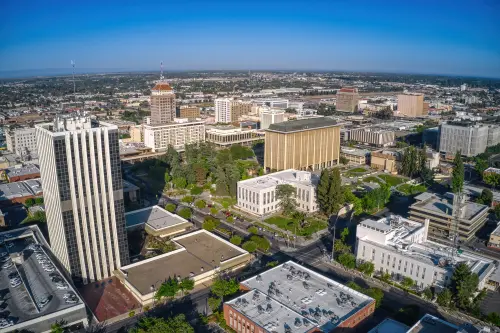

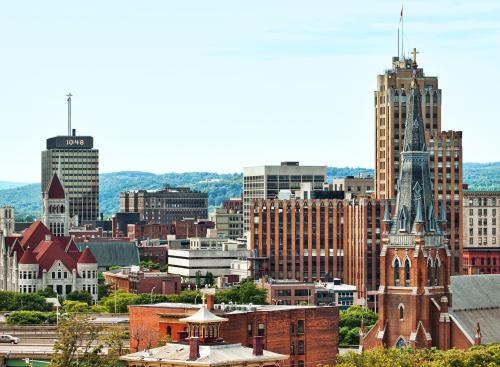

The Brookings Institution is committed to quality, independence, and impact.
We are supported by a diverse array of funders. In line with our values and policies, each Brookings publication represents the sole views of its author(s).



